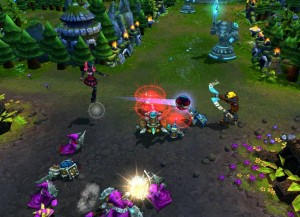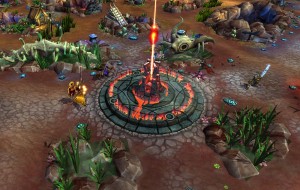League of Legends (PC)
 Several years ago, when Warcraft III was the real-time strategy game of the moment, Blizzard released tools for gamers to create their own levels and units for the game. Some enterprising programmers designed a level that focused on team play between two teams of hero units, each with a few special powers that improved during the game. Thus an entirely new subgenre of real-time strategy, Multiplayer Online Battle Arena (MOBA), was born. Fast forward to late 2009, and Riot Games released League of Legends (LoL for short). Entirely free to download and play, League of Legends is an excellent opportunity for PC gamers to enjoy this new style of game. The game deserves a look from any real-time strategy fan, as it manages to combine an RTS style game with a healthy dose of Role playing (as your hero gains levels and items) all in a quick 30-40 minutes of game play.
Several years ago, when Warcraft III was the real-time strategy game of the moment, Blizzard released tools for gamers to create their own levels and units for the game. Some enterprising programmers designed a level that focused on team play between two teams of hero units, each with a few special powers that improved during the game. Thus an entirely new subgenre of real-time strategy, Multiplayer Online Battle Arena (MOBA), was born. Fast forward to late 2009, and Riot Games released League of Legends (LoL for short). Entirely free to download and play, League of Legends is an excellent opportunity for PC gamers to enjoy this new style of game. The game deserves a look from any real-time strategy fan, as it manages to combine an RTS style game with a healthy dose of Role playing (as your hero gains levels and items) all in a quick 30-40 minutes of game play.
In a normal game, two teams of five players use their heroes to escort little computer-controlled minions across the game board, past a series of defensive turrets in order to assault and destroy the enemies home base. The first team to destroy their opponents’ home base wins the game. Since both teams are escorting their minions across the board, battles erupt in the middle of the board. While killing opposing heroes (who then respawn after a delay) grants a player gold and experience and some gold and experience is granted passively throughout the game, the majority of a player’s gold and experience income will come from the destruction of an opponents’ minion creatures. Players may return to base to heal and purchase items with their gold to upgrade their characters. Heroes also increase in level during the game and each level allows a player to choose which of four heroic skills to improve. While the available items are the same for every character, every hero has a unique passive ability as well as four unique active skills that define the look and feel of that hero. One of the game’s greatest strengths lies in the multitude of unique, interesting heroes available within the game. They have a wealth of different personalities and abilities and can require many different play styles.
There are three main lines of assault across the board, so most games begin with small skirmishes of one or two heroes and their accompanying minions trying to control their “lane” and earn experience and gold faster than the opponent. Any hero that manages to gain levels faster than their opponents will have a significant advantage. Eventually, players will be high enough level to begin to roam around the board in order to gang up on opposing heroes. Due to the death penalty (a delay before one can respawn), as well as the bonus gold and experience for killing heroes, the victor is most often the team with the most hero kills. While tactical decisions are at a premium in close hero combat, long-term strategy also plays a role as it is generally better to have each member of a team take on one or more roles (attack, support, defense) as they develop their characters. That may seem like a lot to understand, but a handy tutorial mode walks players through their first practice game and explains all the relevant details in a easy to digest manner.
In addition to in-game decisions (choosing a character to play, purchasing items, and upgrading skills) players also accrue experience and resources in a player account. Players start at level 1 and can progress up to level 30. Every level earns a “mastery” skill point and a “slot” for special Runes. The mastery skill tree has three areas – offense, defense, and ultility – and players can customize their mastery skills before a game, in order to take best advantage of their selected character. The Rune slots, however, are filled with special items that must be purchased. Thus a level 30 player will start with a distinct advantage over a lowly level 1 even at the start of a game since the higher level player will have 30 mastery points spent and we using 30 runes to boost their statistics. Once gamers reach 30th level (and thus can be using a full set of runes and masteries) gamers may participate in ranked matches, either as a team or as a solo player. These games have some of the stiffest competition, but also provide bragging rights for players for their standings on the boards. It will take a while for a new gamer to progress to level 30. Playing a few games per day, I would expect it to take 4-6 months. Of course, in the meantime players will be earning IP points to spend on their Runes as well as improving their level of play (so as to not embarrass themselves or their team when going into ranked competition.)
The entire commerce portion of the game is surprisingly well-thought out and impressively fair. There are two types of “money” in the game. RP can only be purchased with cash, and can then be used to unlock new champions (heroes) as well as purchase new and different “costumes” for specific heroes. All players earn IP points for playing games, and IP can also be used to unlock new champions. However, IP points are the only way to purchase Runes. Thus, players who want to spend money on the game can easily unlock any champion they wish, and dress their champion up in whatever fancy outfit they choose. However, they have to earn their IP points, just like every other player, in order to buy their Runes. In other words, you can’t pay money to obtain anything that would grant you increased power. At the same time, players who are looking for an entirely free experience can still play the game, and will simply have to save up extra IP points from playing games in order to unlock their favorite champions as well as any Runes they’re hoping to buy. To give everyone a chance to try out the many (90 plus) champions available, every week there are 10 champions selected that are free for anyone to play. Once a player finds a favorite, they can then save up their IP points to buy it from the store without spending a dime. Simply put, money can buy you cool characters and showy clothes, but it won’t buy you power. It seems to be a great marketing model as many players enjoy spending a bit on their hobby while keeping the game free ensures a large player base for healthy matchmaking games.
In addition to the main gameplay modes, there are a few additional ways to play the game that Riot has provided for variety’s sake. First, there is a special 3 vs 3 player map with only two “lanes” of minions rather than the standard three. This map is great for groups of three players who can’t find a fourth or fifth to make a full team (and don’t want to be matched up with a random forth and fifth…) Finally, there is an entirely different mode of play called Dominion. In Dominion games, champions begin at 3rd level and have a pile of starting cash. Offensive powers are mildly enhanced to encourage champion duels, and heroes gain gold and experience points at an enhanced rate throughout the game. The goal of the game is to control a majority of 5 different turrets placed around a circle. The team with a majority will sap team life points from the other team until one team reaches zero. The small map and accelerated experience and leveling makes for a much faster and more conflict ridden game. Dominion mode is playable in 10 to 20 minutes whereas normal games typically can last from 30 to 50 minutes.
How does this game look for family gamers? As always, parents need to be aware of online gaming. There isn’t a voice option, but players can still type in offensive text notes, etc… However, Riot has invested a significant effort into The Summoners Code, which attempts to promote good behavior and prevent poor behavior (such as leaving mid-game, verbal abuse, intentionally poor play, etc…) Problems that are reported by players undergo peer review, and offenders can then be reprimanded by banning them from the game for increasingly longer periods of time. This works surprisingly well, although trash talk and mildly offensive language still creeps in about a third of the games I’ve played. To avoid some of this problem, gamers can avoid playing directly against human opponents. Riot has recently released a large patch which provides many, many computer controlled champions so that gamers can set up games to be cooperative teams of 5 players against 5 computer controlled champions. Games can even be played on the Dominion map against computer controlled players. This is a great way for gamers to get their feet wet in the game before leaping into the more intense player vs player games.
Those wishing for an extremely safe environment can even play custom setups on the normal map. One can choose any number of computer controlled AI players (on either side), invite specific players (or leave slots open for random walk-ons), and then play to their hearts content without having to worry about the attitudes of other gamers. The only caveat I have for a family gaming together in this way (it IS free after all, so multiple accounts for a family isn’t a big deal) would be to check their Internet connection. While the lag isn’t too bad when piped through a big T1 line like an educational institution or corporation, playing multiple players through a single cable modem has proven to be very taxing on the network.
League of Legends is an amazing game for its price. It is, by far, the best free game I have played in years. Even better, while there are mild benefits for spending a little bit of money (fun costumes, easier/quicker access to more champions), the game remains very enjoyable for those who go for the entirely free route. As an online game, there are some pitfalls of which to be wary, but judicious use of custom games and games vs the AI might serve as a fun time for family gaming. This is especially true since there are no upfront costs or monthly fees about which to worry. As I mentioned before, there is little or no barrier to entry, so anyone even remotely interested in the game should give it a try.







Discussion Area - Leave a Comment